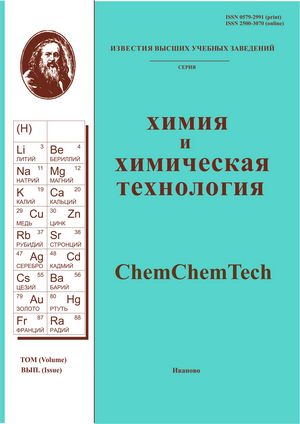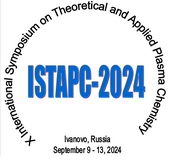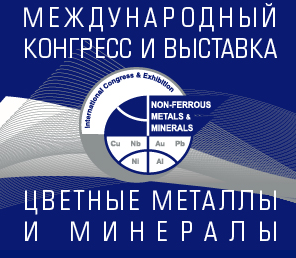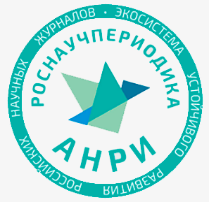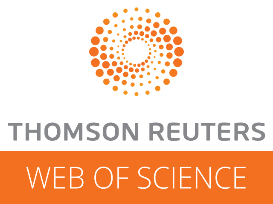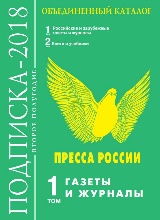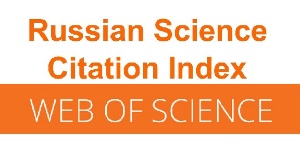ФИЗИКО-ХИМИЧЕСКИЕ СВОЙСТВА ОТБЕЛЬНОЙ ГЛИНЫ
Аннотация
В работе изложены результаты исследования физико-химических свойств отработанной (зажиренной) отбельной глины после использования ее на маслоэкстракционном предприятии для очистки растительного масла от окрашенных веществ. В исследованиях использовали рентгенофазовый, ИК-спектральный, гранулометрический, электронно-микроскопический анализ. Исследовалась глина исходная и зажиренная термообработанная при 300 °С и 350 °С. Выявлено, что исследуемая глина является мономинеральной с преобладанием монтмориллонитовой составляющей, в качестве примеси присутствует кварц. Лазерный гранулометрический анализ исследуемых образцов глины показал, что частицы отбельной глины в основной своей массе имеют размеры, не превышающие 100-200 мкм, и пористую высокоразвитую поверхность, а удельная поверхность (Sуд), определенная по методу БЭТ на установке ТriStar II 3020 производства Мicromeritics (US), составляет 32 м2/г. Исследования сорбционных свойств отбельной глины показали, что сорбционная емкость, определенная в статических условиях для исходной глины по ионам Ni2+, составляет 0,25 ммоль/г, а для обожженной – 0,428 ммоль/г, что в 1,7 раза выше по сравнению с исходной глиной. Это, по-видимому, можно объяснить увеличением удельной поверхности и пористости при термообработке. Анализ микрофотографий, полученных с помощью сканирующего электронного микроскопа высокого разрешения TESCAN MIRA3 LMU (Чехия), показал, что структура отбельной глины состоит из пористого инертного материала, причем его пористость и шероховатость в результате термообработки увеличиваются. Изучение образцов глины в инфракрасном излучении показало, что в ходе термообработки отработанной зажиренной отбельной глины меняются ее структурные особенности: происходит разрушение триглицеридов жирных кислот и других органических соединений, присутствующих в масле после отбеливания.
Для цитирования:
Свергузова С.В., Шайхиев И.Г., Сапронова Ж.А., Лупандина Н.С., Воронина Ю.С., Гафаров Р.Р. Физико-химические свойства отбельной глины. Изв. вузов. Химия и хим. технология. 2023. Т. 66. Вып. 6. С. 76-84. DOI: 10.6060/ivkkt.20236606.6780.
Литература
Lupandina N.S., Sapronova Zh.A. Modified Bleaching Clay as a Sorption Material. IOP Conf. Ser.: Earth Envi-ron. Sci. 2020. 459. P. 042063 (in Russian). DOI: 10.1088/1755-1315/459/4/042063.
Sapronova Zh.A., Gomez M.J. Evaluation of the reagent properties of clays from the Angolan Kateti deposit. Vestn. BGTU named after V.G. Shukhov. 2014. N 1. P. 164-167 (in Russian).
Khankhasaeva S.Ts., Badmaeva S.V. Adsorption of methanyl yellow dye on Fe-modified bentonite clay. ChemChemTech [Izv. Vyssh. Uchebn. Zaved. Khim. Khim. Tekhnol.]. 2022. V. 65. N 5. P. 23-29 (in Russian). DOI: 10.6060/ivkkt.20226505.6438.
Sviridov A.V., Yurchenko V.V., Gindulin I.K., Kamenchenko E.A. Development of a sorption material based on modified aluminosilicates with high adsorption capacity for hydrogen sulfide. Vestn. VGUIT. 2021. 83(4). P. 232-237 (in Russian). DOI: 10.20914/2310-1202-2021-4-232-237.
Khamrakulova M.Kh. The process of bleaching neutralized soybean oil using local bleaching clays. Universum: Tekhn. Nauki. 2020. N 12-2(81). P. 104-105 (in Russian).
Otyrba G.G., Fidchenko M.M., Kamenchuk I.N. The use of natural montmorillonite clays in the process of co-agulation laundries wastewater treatment. Sorp. Khrom. Prots. 2020. V. 20. N 6. P. 773-781 (in Russian). DOI: 10.17308/sorpchrom.2020.20/3057.
Volosatova K.A., Shamanov V.A., Kazymov K.P., Tomilina E.M. Comparison of the characteristics of clay raw materials in the Perm Territory. Vestn. PNIPU. Priklad. Ekologiya. Urbanistika. 2022. N 1(45). P. 59-70 (in Russian). DOI: 10.15593/2409-5125/2022.1.05.
Kormosh E.V., Alyabyeva T.M., Shvetsova M.Zh. Study of the material composition of natural and modified montmorillonite clays for the development of sorbents for wastewater treatment. Usp. Sovremen. Estestvozn. 2019. N 3-2. P. 145-150 (in Russian).
Sakhibov N.B. Sorption properties of bentonite from the Istymtau deposit. Politekhn. Vestn. Ser.: Inzhener. Issled. 2021. N 4(56). P. 38-41 (in Russian).
Muslimov B.B., Ismatov S.Sh., Sharifova N.A.K. Bleaching technologies for refining cottonseed oil. Vopr. Nauki Obrazovaniya. 2017. N 5(6). P. 11-13 (in Russian).
Nadirov K.S., Asylkhanov N.A., Nadirov R.K., Dzhusenov A.U. The use of waste bleaching earths for anti-corrosion coatings. Vestn. Nauki Yuzhnogo Kazakhstana. 2018. N 4(4). P. 129-134 (in Russian).
Lupandina N.S., Sverguzova S.V., Vdovenko O.A. Purification of aquatic environments using waste from the production of vegetable oil. Materials of the All-Russian scientific conference with international participation of young scientists and specialists Innovative technologies for environmental protection in the modern world. Kazan. March 18–19, 2021. Kazan: KNITU. 2021. P. 307-311 (in Russian).
Khisamova A., Salimova L.I., Safarov A.Kh. The use of bleaching clay for building material. Aspirant. 2017. N 4(30). P. 18-21 (in Russian).
Shperber D.R., Bryushkov R.V., Guba E.N. The use of secondary products of refined vegetable oils industry as a feed additive for poultry. Izv. Vyssh. Uchebn. Zaved. Pishch. Tekhnol. 2022. N 2-3(386-387). P. 46-50 (in Russian). DOI: 10.26297/0579-3009.2022.2-3.9.
Akmalkhanov A.T. The use of bentonite and fatty clay in the diets of dairy cows and young cattle. Collection of scientific works of the North Caucasian Research Institute of Animal Husbandry. 2013. V. 2. N 2. P. 102-106 (in Russian).
Gorelova O.M., Kurtukova L.V. Search for ways of waste disposal in the production of vegetable oils. Izv. Kyrgyz. Gos. Tekhn. Univ. im. I. Razzakova. 2019. N 2-2(50). P. 232-237 (in Russian).
Enyutina M.V., Tarasevich T.V., Kostyleva L.N. Reducing the hazard class of spent bleaching earths. Materi-als of the L reporting scientific conference for 2011. Sat. Proceedings of Conf. Voronezh. March 27–29, 2012 Voronezh: VSUIT. 2012. Part 1. P. 198. (in Russian).
Ovchinnikova V.D. The problem of bleaching clay waste disposal from shale industries and ways to solve it. Nauka Obrazovanie: Novoe Vremya. Nauch.-Metod. Zhurn. 2021. N 1(23). P. 4-8 (in Russian).
Mustafaev S.K., Mustafaev E.O., Smychagin O.V., Smychagin S.K. Complex processing of oil and fat pro-duction waste. Elektron. Set. Politem. Zhurn. "Nauch. Tr. KubGTU". 2019. N 1. P. 378-382 (in Russian).
Lukin A.A. Main directions of improvement of techno-logical processes in the oil and fat industry. Vestn. Yuzh.-Ural. Gos. Univ. Ser.: Pishch. Biotekhnol. 2013. V. 1. N 1. P. 15-20 (in Russian).
Rafalson A.B., Konstantinova O.V., Krishtofovich S.N. Some regularities of adsorption on domestic bleaching clay. Vestn. Vseross. Nauch.-Issled. Inst. Zhirov. 2015. N 1-2. P. 33-35 (in Russian).
Suvanova F.U. Rational use of refining waste. Proceedings of the international scientific and practical confer-ence dedicated to the year of ecology in Russia Scientific and practical ways to improve environmental sustainability and socio-economic support of agricultural production. p. Salty Zaimishche. May 18–19, 2017. Solenoye Zaimishche: Caspian Research Institute of Arid Agriculture. 2017. P. 59-64 (in Russian).
Matyushenko N.N. Adsorption refining of vegetable oils. Collection of scientific works of the All-Russian Research Institute of Sheep and Goat Breeding. 2016. V. 1. N 9. P. 123-126 (in Russian).
Peter Larkin. Infrared and raman spectroscopy principles and spectral interpretation. Elsevier Inc. 2011. 230 p. DOI: 10.1016/B978-0-12-386984-5.10002-3.
Barbara H. Stuart. Infrared spectroscopy: fundamentals and applications. John Wiley & Sons Ltd. 2004. 244 p.
Klyuchnikova N.V. X-ray phase analysis of composite materials based on clays. Collection of scientific papers SWorld. 2013. V. 7. N 1. P. 3-10 (in Russian).
Murtazina E.Zh., Sabitova D.A., Shayakhmetov A.U. X-ray phase analysis of aluminous raw materials. Materi-als of the 1st scientific and practical conference with international participation New technologies in materials science. Ufa, December 14, 2015. Ufa: Bashkir State University. 2015. P. 241-248 (in Russian).
Monina L.N. Radiography. Qualitative X-ray phase analysis. M.: Izd-vo Prospekt. 2017. 120 p. (in Russian).
Khadzhiev I.M., Ismailov E.D. On the electron microscopic examination of the modified clay. Aktual. Nauch. Issled. Sovr. Mire. 2019. N 11-1(55). P. 195-199 (in Russian).
Antoshkina E.G., Smolko V.A., Dyskina B.Sh. Electron microscopic studies of refractory clays used in foundry production. Vestn. Yuzh.-Ural. Gos. Univ. Ser.: Metallurgiya. 2007. N 13(85). P. 43-45 (in Russian).
Dzyuzer V.Ya. Analysis of quartz sand granulometric composition. Steklo Keramika. 2015. N 5. P. 29-32 (in Russian). DOI: 10.1007/s10717-015-9748-9.
Kalykova G.S. Complex study of clay deposits. Vestn. Kyrgyz.-Ross. Slavyan. Univ. 2021. V. 21. N 12. P. 178-185 (in Russian).
Balykbaeva G., Tamshybaev T., Kyrgyzbaeva A.M. IR spectra of modified bentonite clay. Vest. Nauki Obraz. 2016. No. 5(17). P. 6-7 (in Russian).
Muzaeva A.M., Muksumova Z.S. IR spectra and derivatograms of clay from the Oktyabrskoye deposit. Vestn. Nauki Obrazovaniya. 2014. N 4. P. 156-159 (in Russian).
Vezentsev A.I., Volovicheva N.A., Korolkova S.V., Sovetova K.S. Material composition and colloid-chemical characteristics of montmorillonite-containing clay of the Taganskoye deposit (Kazakhstan). Vestn. Tekhnol. Univ. 2020. V. 23. N 6. P. 35-39 (in Russian).
Trubitsyn M.A. Workshop on environmental chemistry. Belgorod: BelGU. 2002. Pt. 1. 45 p. (in Russian).
Ibragimov Sh.T., Nurullaev Sh.P., Alikhonova Z.S. Purification of heavy metal ions Cu2+, Zn2+ and Ni2+ from industrial wastewater by adsorption. Nauka, Tekhnika Obrazovanie. 2022. N 4(87). P. 11-14 (in Russian).

